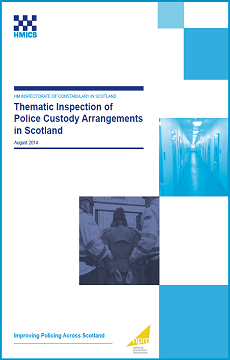The aim of this thematic inspection was to assess the state, effectiveness and efficiency of police custody arrangements in Scotland and to assess the care and welfare of detainees.
Depriving people of their liberty for any reason comes with significant responsibility for their safety and welfare and presents risks that must be carefully managed. The police service is responsible for the proper care and protection of those in custody, including their physical, mental and welfare needs. The risks associated with depriving people of their liberty can be mitigated by high standards within custody centres, robust operating procedures and effective partnership working.
This inspection is part of an ongoing programme of custody inspections which contribute to the United Kingdom’s response to its international obligations under the Optional Protocol to the United Nations Convention against Torture and other Cruel, Inhuman or Degrading Treatment or Punishment (OPCAT). OPCAT requires that all places of detention are visited regularly by a National Preventive Mechanism (NPM), an independent body or group of bodies which monitor the treatment of and conditions for detainees. HMICS is one of several bodies making up the NPM in the UK
Number | Recommendation |
|---|---|
1 | Police Scotland should introduce more efficient processes to better manage capacity across the custody estate. These processes should allow officers to be effectively directed to custody centres where there is sufficient available capacity to accept their detainees. |
2 | Police Scotland should review its approach to single cell occupancy and consider a more proportionate approach to risk assessment allowing local discretion to use multiple cell occupancy where appropriate. |
3 | Police Scotland should reassess the future level of demand and need for detainee transfers alongside the wider management of capacity across the custody estate in order to develop a more sustainable model. The current transfer protocol should be reviewed and incorporated within custody policy. |
4 | Police Scotland should review the wider security of the custody environment and conduct a physical security audit at each custody centre. |
5 | Police Scotland should undertake routine health and safety inspections within custody centres, including a wider review of equipment standards and availability, staff awareness of accident and fire records, and fire evacuation procedures and drills. |
6 | Police Scotland should review its approach to use of force in custody and focus on raising awareness, providing clear guidance and monitoring the use of restraint and force at a divisional level in order to inform policy and training. |
7 | Police Scotland should review its hourly rousing policy and whether it is necessary and proportionate when applied to all detainees regardless of risk. |
8 | Police Scotland should review the availability of showers and exercise for detainees to develop a consistent approach and reflect this within any future estate improvement programme. |
9 | Police Scotland should engage with criminal justice partners and review the solicitor access recording form to improve accessibility. Police Scotland should ensure officer guidance and training emphasises the need to communicate the form’s contents in a manner that is better understood. Police Scotland should also ensure that the Letter of Rights is issued when required during the booking-in process and this is verified in the custody audit process. |
10 | Police Scotland should join with its partners in the NHS, voluntary sector and local authority social care, recognising the role of community planning partnerships and alcohol and drugs partnerships across Scotland, to review the scope of current referral and diversion schemes and seek to address any gaps in provision. |
11 | Police Scotland should secure more robust management and performance information and develop a stronger evidence base to enable the evaluation of benefits and outcomes for the division. |
12 | To further address inconsistencies in practice, Police Scotland should build on its approach to custody audit, with frequency of audits being reviewed and consideration given to additional cross cluster audits. Consideration should also be given to a centralised resource to further support and undertake the additional work. |
13 | Police Scotland should develop a custody training strategy and implementation plan. This should be informed by a training needs analysis which covers all staff working within custody. |
14 | As a matter of urgency, Police Scotland should finalise the Custody Estate Strategy and work in partnership with the Scottish Police Authority and Scottish Government to prioritise investment in the custody estate. |
15 | Police Scotland should seek to engage with its stakeholders as part of its development of a strategic proposal for custody ensuring that there is a shared vision and that further opportunities for joint working are optimised. |


